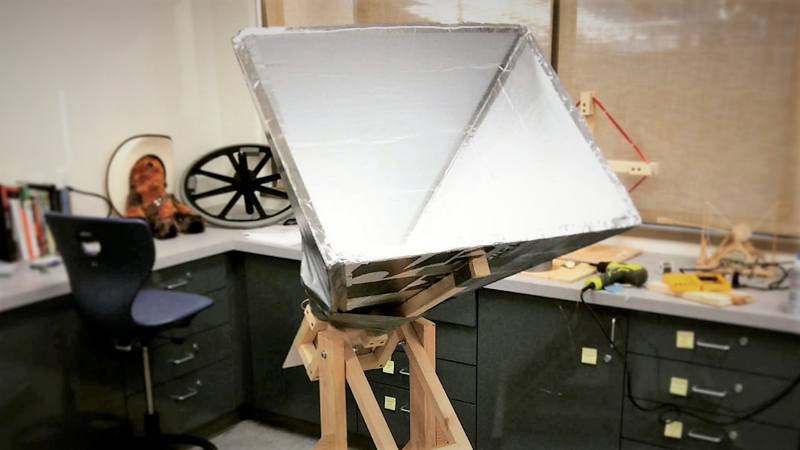Foil-lined foam insulation board, scraps of lumber, and a paint-thinner can hardly sound like the tools of a radio astronomer. But when coupled with an SDR, a couple of amplifiers, and a fair amount of trial-and-error tweaking, it’s possible to build your own hydrogen-line radio telescope and use it to image the galaxy.
As the wonderfully named [ArtichokeHeartAttack] explains in the remarkably thorough project documentation, the characteristic 1420.4-MHz signal emitted when the spins of a hydrogen atom’s proton and electron flip relative to each other is a vital tool for exploring the universe. It lets you see not only where the hydrogen is, but which way it’s moving if you analyze the Doppler shift of the signal.
 But to do any of this, you need a receiver, and that starts with a horn antenna to collect the weak signal. In collaboration with a former student, high school teacher [ArtichokeHeartAttack] built a pyramidal horn antenna of insulation board and foil tape. This collects RF signals and directs them to the waveguide, built from a rectangular paint thinner can with a quarter-wavelength stub antenna protruding into it. The signal from the antenna is then piped into an inexpensive low-noise amplifier (LNA) specifically designed for the hydrogen line, some preamps, a bandpass filter, and finally into an AirSpy SDR. GNURadio was used to build the spectrometer needed to determine the galactic rotation curve, or the speed of rotation of the Milky Way galaxy relative to distance from its center.
But to do any of this, you need a receiver, and that starts with a horn antenna to collect the weak signal. In collaboration with a former student, high school teacher [ArtichokeHeartAttack] built a pyramidal horn antenna of insulation board and foil tape. This collects RF signals and directs them to the waveguide, built from a rectangular paint thinner can with a quarter-wavelength stub antenna protruding into it. The signal from the antenna is then piped into an inexpensive low-noise amplifier (LNA) specifically designed for the hydrogen line, some preamps, a bandpass filter, and finally into an AirSpy SDR. GNURadio was used to build the spectrometer needed to determine the galactic rotation curve, or the speed of rotation of the Milky Way galaxy relative to distance from its center.
We’ve seen other budget H-line SDR receiver builds before, but this one sets itself apart by the quality of the documentation alone, not to mention the infectious spirit that it captures. Here’s hoping that it finds its way into a STEM lesson plan and shows some students what’s possible on a limited budget.
















This is excellent work! Please keep us posted on what you see with your instrument.
Awesome stuff! I got my PhD in mapping neutral Hydrogen (HI) using the Green Bank Telescope. They have the original Ewen-Purcell Horn telescope outside the main offices there.
Funny thing is that when Van der Hulst predicted the HI line, he thought it would be too faint to detect. Now we know it’s actually rare to look up to a random point and not see HI. I remember one of the Green Bank scientists telling me how some of the other grad students would walk by and joke that Ewen was just wasting his time …
Great detail! Thanks for sharing! Reminded me of this article also with way more information: https://hackaday.com/2019/01/20/radio-telescopes-horn-in-with-gnu-radio/
Four comments! That’s it??? This article has way more information regarding the topic… granted… the reddit has links to the article I referenced above work… though still… this article brought it all together.
Figures when we need more people listening and monitoring the radio frequency waves (electric and magnetic fields and charges) and other related forces like sound, ultrasound, etc. in our environment… background signals for starters so to be able to make our databases and training sets for non-target signals and all signals in general set.
https://www.wired.com/story/acoustic-cyberweapons-defcon/
https://www.youtube.com/watch?v=D4huhuSNff8
I’ve been wondering also if anyone has found these large 100m dishes used for listening in space that I added in a video I just put together a story board rough draft that is discussed at about 10 minutes and shown at about 11 minutes.
https://youtu.be/dCfDvDk72kE?t=599 (watch to about 11:14)
Those would be interesting to hack into since looks like a passive reflector.
“But, two people with some spare time, a bit of background, a disorganized stack of references, a slightly less disorganized pile of tools and lumber, radio equipment they didn’t know how to use, and a vague notion that somehow a radio telescope could be made out of all of this actually figured out how and (sort of) why this thing works. ”
Love it – let’s hear more as it progresses!
Followed the link here from Open Physics Lab. What a GREAT project! I’m going to spend the summer going through this, and hope to try it with some of my high school Physics students next year. Thank you so much for taking the time to organize this so beautifully and share it out! Did you publish this in The Physics Teacher?